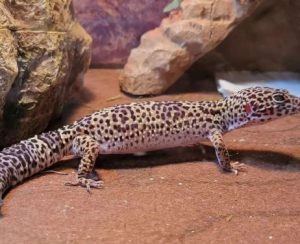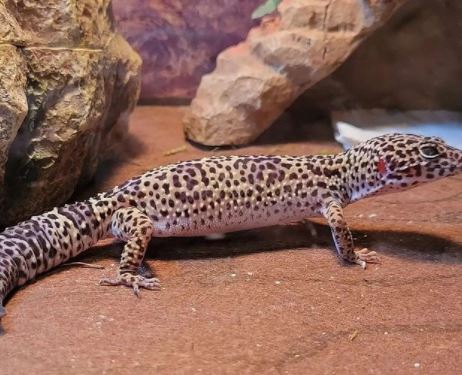Do leopard geckos bites hurt
Do leopard geckos bites hurt: Leopard geckos, scientifically known as Eublepharis macularius, have established themselves as popular pet reptiles among enthusiasts worldwide. These small, desert-dwelling lizards are native to the arid regions of Pakistan, India, and Afghanistan. Over the years, their endearing appearance and fascinating behaviors have captivated the hearts of reptile lovers, making them one of the most sought-after species in the world of herpetoculture.
Brief Overview of Leopard Geckos as Popular Pet Reptiles
 Leopard geckos are renowned for their unique characteristics and relative ease of care compared to other reptiles. With their distinctive yellowish or cream-colored bodies adorned with dark spots or blotches that resemble leopard patterns, they possess a mesmerizing beauty that attracts aficionados from all walks of life.
Leopard geckos are renowned for their unique characteristics and relative ease of care compared to other reptiles. With their distinctive yellowish or cream-colored bodies adorned with dark spots or blotches that resemble leopard patterns, they possess a mesmerizing beauty that attracts aficionados from all walks of life.
One notable advantage for leopard gecko enthusiasts is their small size. Adult specimens typically measure between 6 to 9 inches in length from snout to tail tip.
This compact stature makes them ideal for individuals who may have limited space but still desire a captivating reptilian companion. Furthermore, leopard geckos exhibit a remarkable level of tolerance towards human interaction due to their inherently gentle nature and docile behavior.
Unlike some reptile species that tend to be skittish or prone to aggression when handled by humans, leopard geckos are generally amiable creatures when provided with proper care and attention. This affable disposition contributes significantly to their popularity among both novice pet owners and seasoned reptile enthusiasts alike.
Leopard geckos also possess intriguing adaptations that set them apart from many other reptilian companions. One such adaptation is their ability to regenerate lost tails—a phenomenon known as autotomy.
If startled or threatened by a predator (or even during handling), they can voluntarily detach their tails at specific fracture points known as “tail autotomy planes.” This remarkable defense mechanism not only aids in their survival in the wild but also adds an element of fascination for those observing these captivating creatures. The introduction provides a glimpse into the world of leopard geckos as beloved pet reptiles.
Their visually striking appearance, compact size, and affable temperament make them highly desirable companions for reptile enthusiasts. In subsequent sections, we will delve deeper into the intricacies of leopard gecko bites and explore whether they truly cause discomfort or pain to their human counterparts.
Understanding Leopard Gecko Bites
Explanation of why leopard geckos may bite
Leopard geckos, known for their gentle nature and docile behavior, are generally not prone to biting. However, there are certain circumstances that can trigger them to resort to biting as a means of defense or survival. One common reason is fear or feeling threatened.
While they may appear small and vulnerable, leopard geckos have a natural instinct to protect themselves when they perceive danger. When these reptiles feel threatened or cornered, they may resort to defensive biting as a way to ward off potential predators or perceived threats.
This behavior is essential for their survival in the wild but can also manifest in captive leopard geckos if they feel excessively stressed or fearful. It is crucial for owners to understand that even the most well-tamed leopard gecko might bite under such circumstances.
Mistaking fingers for food due to poor eyesight
 Another factor that can lead to leopard gecko bites is their relatively poor eyesight. These reptiles have limited visual acuity and rely heavily on other senses, such as smell and touch, to identify objects in their surroundings.
Another factor that can lead to leopard gecko bites is their relatively poor eyesight. These reptiles have limited visual acuity and rely heavily on other senses, such as smell and touch, to identify objects in their surroundings.
This reliance on non-visual cues can sometimes result in finger-biting incidents when handling the gecko. Due to their keen sense of smell, leopard geckos may unintentionally mistake fingers for food items during interaction.
They typically associate any movement near them with potential prey and might strike out at an extended finger without realizing it isn’t edible. It’s important for owners and handlers to be aware of this possibility and take precautions while handling leopard geckos by ensuring slow movements and proper hand placement.
Understanding the factors that contribute to leopard gecko bites can help owners anticipate situations where biting may occur and take necessary precautions. By recognizing that fear or feeling threatened triggers defensive behavior in these reptiles and being mindful of their limited eyesight and predatory instincts, handlers can foster a safer environment for both themselves and their leopard geckos.
The Anatomy of a Leopard Gecko Bite
Description of leopard gecko teeth structure and arrangement
Leopard geckos possess a fascinating oral anatomy that is well-adapted to their carnivorous lifestyle. Their teeth, although small, are sharp and efficient in gripping prey. These teeth are located along their upper and lower jaws, arranged in multiple rows for maximum biting prowess.
The precise arrangement of teeth allows for a firm grip on their prey while feeding. Each tooth is curved slightly backward, with a pointed tip that aids in puncturing the skin or exoskeleton of their prey.
The upper jaw of a leopard gecko contains around 100 tiny but formidable teeth, while the lower jaw houses around 80 teeth. These numbers may vary slightly among individuals.
The teeth are evenly spaced along both jaws, ensuring an even distribution when biting down on prey items. This arrangement allows them to exert proper pressure when grasping and holding onto their food source.
Small, sharp teeth designed for gripping prey
Leopard geckos possess teeth specialized for gripping rather than tearing or chewing like mammals do. Their small size facilitates precision when aiming to bite or grasp objects, be it food or other items within their environment.
These sharp little structures enable them to securely latch onto prey without letting go easily. The shape of leopard gecko’s individual teeth contributes significantly to their efficiency as predators.
Each tooth has pointed edges that aid in piercing through the exterior layers of insects or other small animals they consume as part of their diet. The sharpness enables them to penetrate even tough exoskeletons effortlessly, ensuring they can access the nutrient-rich insides.
Multiple rows of teeth in their jaws for efficient biting
What sets leopard geckos apart from other reptiles is the presence of multiple rows of replacement teeth within both the upper and lower jaws. These rows allow them to have a continuous supply of functional teeth, compensating for any lost or damaged ones. Leopard geckos typically have two or three rows of replacement teeth behind the visible front row in each jaw.
When a tooth is lost or broken during feeding or other activities, the next tooth in line moves forward to fill in the gap, ensuring a seamless biting mechanism. This regenerative feature guarantees that leopard geckos always have functional and efficient teeth available.
Overall, the anatomy of a leopard gecko’s bite showcases their incredible adaptation for capturing and consuming prey. The structure and arrangement of their teeth provide them with exceptional gripping capabilities that aid in securing food items effectively.
Multiple rows of replacement teeth ensure they can sustain their predatory lifestyle without significant disruptions due to tooth loss or damage. Understanding these aspects allows us to appreciate the marvels of nature and better comprehend the potential impact and sensations associated with being bitten by a leopard gecko.

Sensitivity and Pain Perception in Leopard Geckos
Do leopard geckos bites hurt: Discussion on the sensitivity of leopard gecko jaws and mouth area
Leopard geckos possess a remarkable level of sensitivity in their jaws and mouth area, which plays a crucial role in their survival as predatory reptiles. Their ability to detect prey movements is primarily facilitated by specialized nerve endings found within their oral cavity.
These nerve endings, known as mechanoreceptors, are highly sensitive to even the slightest vibrations or disturbances in their environment. Through these mechanoreceptors, leopard geckos can precisely locate and track prey items, ensuring successful hunting opportunities.
The jaw sensitivity of leopard geckos is particularly noteworthy. As they bite down on their prey, they rely on delicate sensory mechanisms within their jawbones to assess the size, texture, and movement patterns of potential meals.
This heightened sensitivity allows them to make quick assessments about whether an object is edible or not. Although this mechanism aids them in distinguishing between food items and non-food objects, it can sometimes lead to accidental bites when they mistake fingers for food due to poor eyesight.
Nerve endings in the oral cavity that allow them to detect prey movements
Leopard geckos possess an intricate network of nerve endings within their oral cavity that enables them to detect even subtle prey movements. These specialized nerves are connected to structures known as neuromasts, which are tiny sensory organs responsible for detecting vibrations and pressure changes in the surrounding environment.
By utilizing these neuromasts along with other sensory structures such as taste buds and olfactory receptors located on their tongue, leopard geckos can effectively locate potential meals. The combination of these sensory mechanisms allows leopard geckos to thrive in various habitats where they encounter different types of prey items.
Whether residing within rocky deserts or forested areas, these reptiles have adapted well by developing a highly specialized sense of touch in their mouth area. It is through this sensitivity that they are able to capture and consume live insects, their primary source of nutrition in captivity.
Limited pain receptors compared to mammals
Do leopard geckos bites hurt: While leopard geckos possess an impressive sensory system that enables them to hunt effectively, it is important to note that their pain perception differs significantly from mammals. Unlike humans and other warm-blooded animals, leopard geckos have limited pain receptors in their bodies.
This means that they may not experience pain in the same way that we do. Although bites from leopard geckos can cause discomfort, particularly if they latch onto sensitive areas such as fingertips or exposed skin, the level of pain experienced by humans is generally minimal.
However, individual sensitivity may vary, and factors such as the size and age of the gecko can influence the severity of a bite. Understanding these distinctions helps both reptile enthusiasts and potential owners to appreciate leopard geckos for their unique biology while also promoting responsible handling practices.
Do Leopard Gecko Bites Hurt?
Explanation that pain perception is subjective and varies among individuals: When it comes to determining if leopard gecko bites hurt, it’s important to understand that pain perception can vary from person to person. What might be considered painful for one individual could be merely uncomfortable for another. Additionally, pain perception in reptiles differs significantly from that of mammals, including humans.
While leopard geckos may bite with force, their bite may not elicit the same level of discomfort as a human bite would. Comparison between human and leopard gecko pain thresholds: Human skin is considerably more sensitive than reptile skin.
Our skin contains numerous nerve endings designed to detect even the slightest touch or pressure. In contrast, leopard geckos possess thicker skin with fewer nerve receptors dedicated to sensing pain.
Therefore, they may not experience or perceive the same level of discomfort when biting as a human would if bitten by another human. Leopard gecko bites may cause discomfort but are usually not excruciatingly painful: While being bitten by any creature can be startling and potentially uncomfortable, leopard gecko bites are generally not excruciatingly painful for humans.
Their teeth are relatively small and designed primarily for gripping prey rather than inflicting severe injury. Most commonly, you’re likely to experience mild discomfort or irritation from a bite rather than intense pain.
Factors Influencing Bite Severity
 Do leopard geckos bites hurt: Size and age of the leopard gecko: The size and age of the leopard gecko can impact the severity of its bite. Younger or smaller geckos generally have less powerful bites due to their developing jaw strength and smaller teeth size.
Do leopard geckos bites hurt: Size and age of the leopard gecko: The size and age of the leopard gecko can impact the severity of its bite. Younger or smaller geckos generally have less powerful bites due to their developing jaw strength and smaller teeth size.
On the other hand, larger adult specimens have more robust jaws and teeth which can potentially exert more force when biting. It’s important to be aware of the size and age of the gecko to gauge the potential strength of its bite.
Younger, smaller geckos have less powerful bites: As mentioned earlier, younger or smaller leopard geckos tend to have less powerful bites. This is because their jaws and teeth are still developing, and they may not have fully developed the strength required to deliver a forceful bite.
However, it’s essential to exercise caution even with younger geckos as they can still nip if they feel threatened or scared.
Adult or larger specimens may exert more force when biting: Adult leopard geckos or larger specimens possess stronger jaws and teeth capable of delivering a more forceful bite.
While their bites are generally not intended to cause significant harm, it is wise to approach them carefully and handle them with respect. Proper handling techniques can significantly reduce the risk of experiencing a painful bite from an adult leopard gecko.
Handling Techniques to Avoid Bites
A: Tips on proper handling techniques to minimize the risk of being bitten: When interacting with leopard geckos, following proper handling techniques is crucial in avoiding potential bites. Approaching slowly and calmly can help prevent startling the gecko, reducing its likelihood of perceiving you as a threat.
Never try to grab or squeeze a leopard gecko forcefully as this can provoke defensive behavior from them. Instead, use gentle and supportive hand motions while ensuring that your grip provides security without causing discomfort or excessive pressure on their body.
To sum up do leopard geckos bites hurt
While there may be variations in pain perception among individuals, leopard gecko bites are generally not considered excruciatingly painful for humans due to differences in skin sensitivity and the anatomy of their teeth. These reptiles possess smaller teeth designed for gripping prey rather than inflicting severe harm. Factors such as the size and age of the gecko can influence the severity of its bite, with younger or smaller geckos typically having less powerful bites compared to adult or larger specimens.
By employing proper handling techniques and approaching leopard geckos calmly, one can reduce the risk of being bitten. Remember, these endearing creatures are known for their docile nature, making them delightful companions for reptile enthusiasts.


